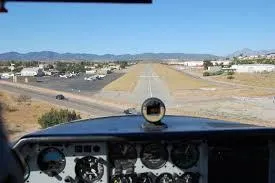2-SECOND BURSTS
SHORT THOUGHTS ON LEADERSHIP, DECISION-MAKING, FLIGHT, AND OTHER TOPICS OF THE DAY
ARTICLES

Sitting On Your Hands
I occasionally teach new pilots how to fly. It gives me an excuse to get airborne, to refresh my own flying skills and share my love of aviation with someone new to the thrills of overcoming gravity in an aircraft. I have realized that it is also a perfect place to practice some key leadership principles.
Many of you have probably taught a young driver how to manage a car and become a safe commuter with their four-thousand pound weapon. I have taught five drivers to this point. It is not a comfortable position to be sitting next to a person who barely understands the rules of the road, has limited experience handling a car, yet has the confidence to tell you that all is Ok as they barely miss a semi going 70-miles an hour down the freeway. They chafe at your instruction and quick intakes of breath as they show you that 'parking by braille' can really be a 'thing', all while telling you to relax. But survive I did, and all of my former students are now good, safe drivers with fewer speeding tickets than me.
Compare that to teaching a new pilot how to fly a plane. The most dangerous phase of flying invariably have to do with takeoff and landing. Imagine teaching someone how to gently place a two thousand pound tricycle on the ground while traveling at between fifty and one hundred miles per hour. No stress. First you teach them about control inputs, have them memorize the right speeds to land, then demonstrate what the 'picture' looks like as they approach the ground, break the descent rate, slow the airplane down to just above a stall, and set it down--first on two wheels, then all three--all while keeping the plane in the center of a narrow strip of pavement. It is about getting a feel for how high above the runway you are, being at the right speed, adjusting for the winds, and being gentle on the control inputs so as to avoid careening off the runway, scraping a wing on the ground, or worse.
After teaching the basics and providing a few examples of what a good landing looks and feels like, I then have them take control of the aircraft to try a few. I let them know I'm shadowing them on the controls and provide some inputs to both keep us safe and give them a feel for what the control pressures are like. Little by little, though, I provide them with fewer and fewer input, eventually resting my hands in my lap where I still can reach the controls but keep away from them as much as I can. As I make this progression, I say less and less about their input and let their brain focus on their next steps instead of listening to me.
The last thing I do to demonstrate confidence in them and let them know they are 'in control' is I sit on my hands, a visual cue that the student can see that I'm not going to touch the controls at all. After coaching them to relax and providing them with a number of practice landings, this move invariably causes each student pilot to breathe more rapidly, grip the controls tighter, and start to sweat with nerves. The first few landing attempts are often shaky, but they eventually figure it out and become confident in their ability to safely land a plane. I then ask them to land, pull over off the runway, then I climb out and tell them to go take a few laps around the pattern by themselves. As an instructor/leader, there is no better feeling than seeing your protege fly away and return safely in a vehicle that they were often afraid of just a few hours prior. Quickly, each student is on their way to becoming an unsupervised pilot that no longer needs my coaching and direction. Those same students may fly a bit differently than me, but that is OK as long as they honor the laws of physics.
Any leadership role should follow the same pattern. If we make ourselves indispensable as the leader, we are not leading. We are simply directing, getting others to perform the tasks in front of us and keeping ourselves stuck in those tasks. By providing a picture of what right looks like, teaching basic skills, then trusting our people with that 'picture', we expand our own capabilities and that of our team. Trust breeds ownership, confidence, and allows us to look forward instead of being stuck on the task at hand. It turns our team into thinking, reacting, empowered contributors instead of simply rule followers.
It all truly starts when we sit on our hands.

CONTACT DEREK!

MEDIA INQUIRIES
Members of the press are welcome to contact us regarding any requests at [email protected] ;
(385) 777-6285

